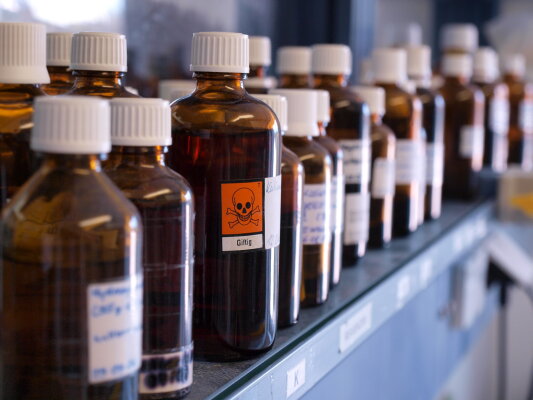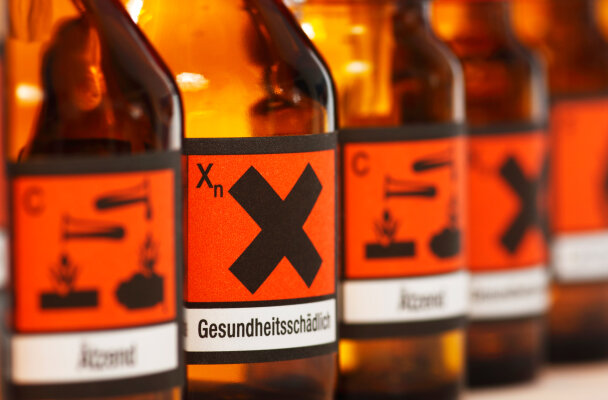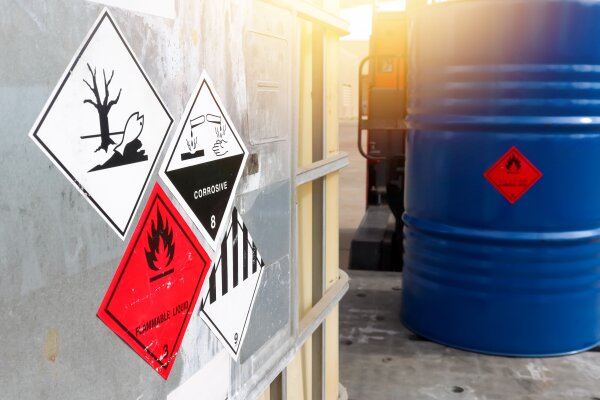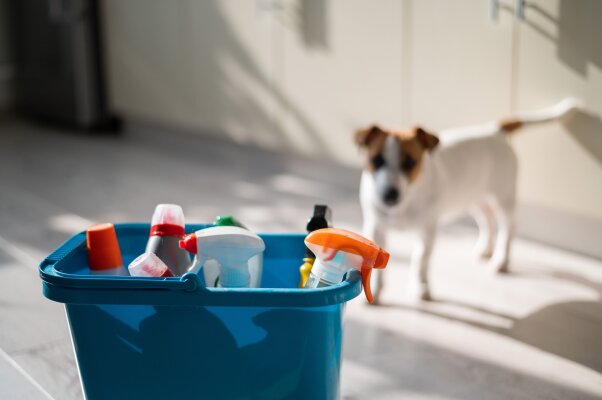The exact difference: dangerous goods and hazardous material

When it comes to the transport of hazardous substances, the terms “dangerous goods” and “hazardous substance” are not infrequently used synonymously by mistake. In fact, these terms derive from different definitions, so they must be strictly separated. We have briefly summarized here which further subdivisions there are and where the legal differences lie for dangerous goods and hazardous substances.
What is a hazardous substance?
When the term hazardous substance is used, it refers to mixtures, substances and products that have hazardous properties and can have a negative impact on people or the environment. These include acute chronic damage as well as flammable, explosive or environmentally hazardous representatives.
In addition, there are substances to which a limit value can be assigned as well as mixtures and articles that meet the criteria of Regulation (EC) No. 1272/2008 (CLP). In addition, those whose production generates hazardous and explosive substances. The Hazardous Substances Ordinance (GefStoffV) provides the basis for the substance definition. It also specifies that substances are considered hazardous if they can be absorbed into the body by inhalation, orally, dermally or subcutaneously. This plays a crucial role in hazardous materials management in particular.
Due to this rather broad definition, there are a number of substances, mixtures and articles that are to be classified as hazardous substances. These occur not only in industry and manufacturing, but also surround us regularly in everyday life. Examples of such substances include the following:
- Various chemicals (such as ethanol, sulfuric acid or nicotine)
- Diesel engine emissions
- Fuels
- Wood dust
- White smoke
- Anesthetic gases
- Ozone
What is a dangerous good?
This contrasts with dangerous goods, which in turn are defined differently. Thus, dangerous goods include substances and objects that pose a threat to public safety, order, and the life and health of humans and animals – in connection with a transport or carriage of these substances. The basis for this definition is the Dangerous Goods Transport Act (§ 2 GGBefG).
The difference between dangerous goods and hazardous substances is therefore that dangerous goods are in a transport and special protective measures are necessary. For this purpose, these goods are divided into dangerous goods classes and marked with warning signs, GHS symbols and UN numbers. The reason behind this is quite simple: Should an accident or damage occur on the road, this is the only way to take the right measures immediately.
Definition of dangerous goods according to the Transport of Dangerous Goods Act
The GGBefG stipulates in § 2 establishes the following wording as a precise definition of dangerous goods: “Dangerous goods within the meaning of this Act are substances and objects which, due to their nature, properties or condition, may pose a risk to public safety or order, in particular to the general public, to important common property, to human life and health, and to animals and property, in connection with their transport”.
However, transportdoes not only include the actual process of moving the goods, but also the taking over, delivery, temporary stays, packing, unpacking, manufacturing and importing of these substances. In addition, combined transport and a transshipment fall within this definition. This is specified in line 2 of § 2.
Transport of dangerous goods according to ADR and RID
The regulations for the transport of dangerous goods are correspondingly strict and are subject to several legal requirements at once. Particularly important are the provisions of the ADR (European Agreement concerning the International Carriage of Dangerous Goods by Road), where, in addition to classification and labeling, documentation and construction and testing requirements during transport are regulated. Important markings are mainly these:
- Warning signs: The various warning signs provide colored orientation and can be unfolded. They are divided into several categories. A neutral warning sign refers to dangerous goods of all kinds, while tank transports also require a warning sign with a number to indicate the danger. If waste is transported, a separate waste warning plate is due. Heated substances also have their own panel – this one shows a thermometer in a red triangle.
- GHS Symbols: The GHS symbols are small hazard symbols that must be included on the hazard labels for transport. They range from GHS01 to HGS09 and categorize properties such as flammable, explosive, toxic or corrosive.
- UN number: In addition, the van must be marked on the outside with a four-digit UN number, which must appear at the bottom of the orange warning plates. It provides information for recording the hazard potential emanating from the transported substance.
In addition, there is a labeling obligation according to RID (Reglement concernant le transport international ferroviaire de marchandises dangereuses) if the dangerous goods are transported on rails.
The different classes of dangerous goods
According to ADR, dangerous goods are also divided into nine different dangerous goods classes. This classification also helps to determine the hazardous nature of the substances for transport so that correct action can be taken in the event of damage. Incidentally, there is no difference here between dangerous goods and hazardous substances, since both must be classified in such a class.
Dangerous goods class 1
The first class of dangerous goods includes explosive substances that can explode rapidly by sparking or fire and/or are considered to be mass explosive. In addition, there are substances with the risk of forming splinters and explosive fragments or detonating due to a change in air pressure. 6 subclasses are differentiated. Fireworks, for example, can be cited as well-known examples.
Dangerous goods class 2
Dangerous goods class 2 includes gases and gaseous substances that may be considered spontaneously flammable and partially toxic. If high pressure occurs, severe hazards sometimes result. A capital letter is also used as an identifier. Examples of representatives of dangerous goods class 2 are propane gas, hydrogen or hairspray.
Dangerous goods class 3
Dangerous goods class 3 substances are highly flammable and liquid. As a definition, the liquid state occurs at 20°C and 1.013 bar. In addition to the classification in this class, there are other classification codes that show additional properties. Dangerous goods class 3 substances include, for example, alcohol, gasoline and some liquefied metals.
Dangerous goods class 4
Dangerous goods class 4 includes solid substances and objects that have self-igniting properties and can become a hazard if they come into contact with air or water. A distinction is made between subclasses 4.1 (flammable solids, self-reactive and desensitized explosives), 4.2 (spontaneously combustible substances) and 4.3 (substances which, in contact with water, emit flammable gases). Examples include sulfur, zinc dust and coal.
Dangerous goods class 5
Dangerous goods class 5 includes flammable substances that do not necessarily have to be flammable themselves. However, they have the potential to set other materials on fire during transport. Here, too, there are subclasses: Division 5.1 includes flammable substances, while Division 5.2 is reserved for organic peroxides. Typical examples are oxygen, hydrogen peroxide and dibenzoyl peroxide.
Dangerous goods class 6
In the dangerous goods class 6 it becomes toxic– all substances that can harm the human organism after an entry fall into this category. In addition to pathogens, pesticides are also found in this group. Dangerous goods class 6 is divided into subgroup 6.1 (toxic substances) and subgroup 6.2 (infectious substances). These include hospital waste and arsenic.
Dangerous goods class 7
Dangerous goods class 7 is reserved for radioactive materials. They emit radioactive radiation, so they can cause serious damage to health. Three categories are distinguished (I-WHITE, II-YELLOW and III-YELLOW), which must be made visible during transport. Examples of representatives of dangerous goods class 7 are uranium, plutonium and various medical instruments such as X-ray equipment or nuclear medical imaging equipment for scintigraphy.
Dangerous goods class 8
Hazardous goods class 8contains corrosive substances. These have a harmful effect on both people and objects. In most cases, the damage is irreversible. In addition, there are also substances that can form a corrosive vapor or mist. These include, for example, sulfuric acid, hydrochloric acid and caustic soda.
Dangerous goods class 9
The last of the bunch is dangerous goods class 9. All hazardous substances and articles that do not fall into any of the other categories are grouped here. Thus, chemical and toxicological hazards as well as physical hazards are represented. Common examples include airbags, asbestos and dry ice.
Is a hazardous substance also dangerous goods?
In principle, it can be said that there is a lot of overlap in the case of hazardous substances and dangerous goods. However, they are not exactly the same – external circumstances contribute to the fact that affiliation can change. For example, hazardous materials law only applies on the company’s own premises, while dangerous goods law applies to incoming and outgoing goods.
Consequently, a hazardous substance is only a dangerous good if it is in transport or otherwise carried. On the other hand, a hazardous material is always a hazardous substance – just outside the company’s own premises.
Legal information on the difference between dangerous goods and hazardous substances
The fact that “hazardous material” and “dangerous goods” do not always describe the same substance is also evident from a legal point of view. Thus, there are different regulations that apply to hazardous materials law and dangerous goods law. These look like the following:
Hazardous Substances Law
The law on hazardous substances covers both thehandling and storage of substances on the company’s own premises. In addition to appropriate employee protection and environmental protection, this also includes water pollution control. Thus, hazardous substances law is also considered occupational health and safety law, which is why it is administered by the Federal Ministry of Labor and Social Affairs (BMAS).
Dangerous Goods Law & CLP Regulation
Hazardous goods law, on the other hand, regulates all legal requirements and obligations in the transport and carriage of corresponding hazardous goods. Therefore, it is a traffic law that falls under the jurisdiction of the Federal Ministry of Transport and Digital Infrastructure (BMVI). The CLP Regulation, which specifies not only the correct classification and labeling, but also the packaging, is decisive.
Crucial difference: dangerous goods and hazardous substances
Although every hazardous material is a hazardous substance, not every hazardous substance is considered a hazardous material – the difference is made by whether the substance is in transit or not. On this basis, not only different labels apply, but also different legal requirements. This is one of the reasons why it is essential to know the difference between hazardous goods and hazardous substances!
FAQ
A hazardous substance is a substance or mixture that may havea harmful effect on humans and/or the environment. In addition, substances with limit values and those according to the CLP Regulation fall into this category.
Hazardous goods, on the other hand, are all hazardous substances that are carried or transported. This results in supplementary requirements with regard to classification, labeling and packaging.
The transport of dangerous goods is legally regulated by the law on dangerous goods. The CLP Regulation is particularly relevant. As traffic law, hazardous goods law falls under the jurisdiction of the Federal Ministry of Transport and Digital Infrastructure (BMVI).
The class of a dangerous good indicates which hazard characteristics apply to the transport. The 9 classes are partly further differentiated into subclasses and equipped with packing groups, compatibility groups, hazard level and classification codes.
Do you have questions about the topic or would you like to suggest a topic? Please contact us by phone at +49 30 2096579 00 or send us an email at info@medsolut.com.




